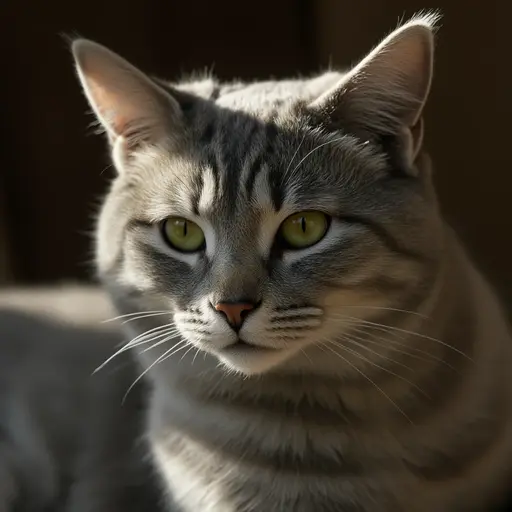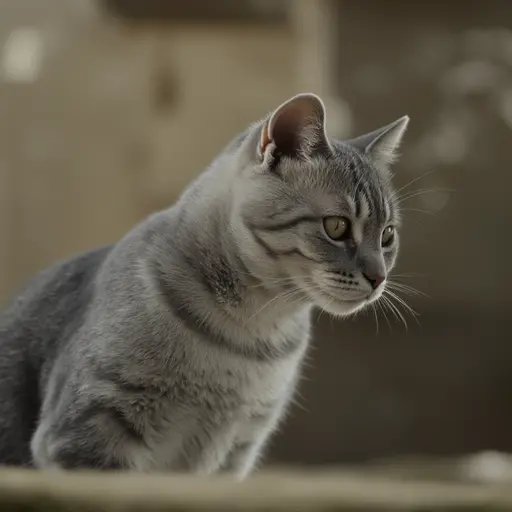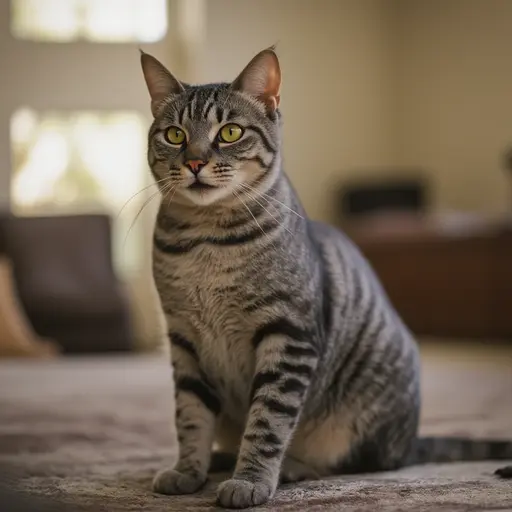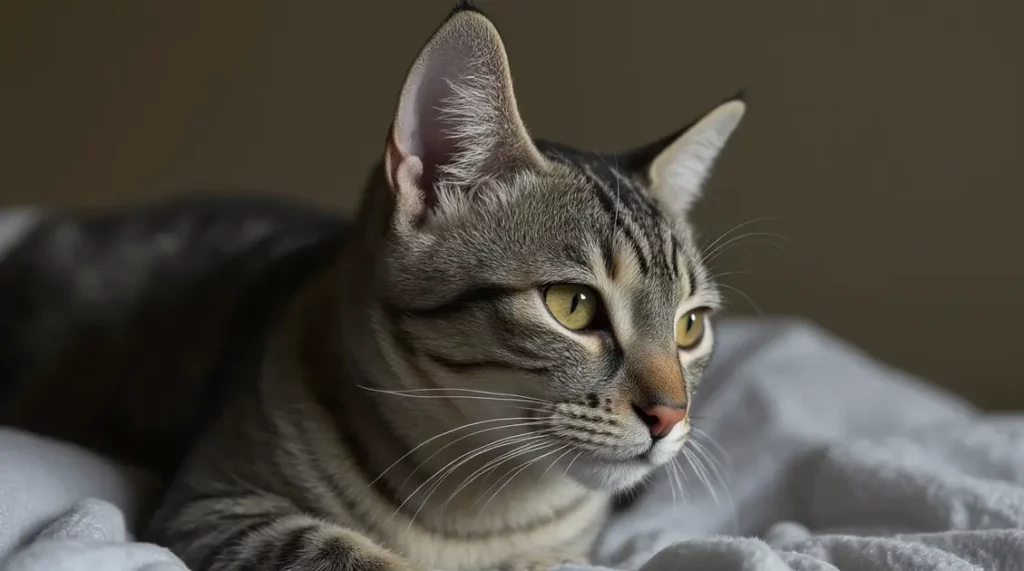Renowned for their striking appearance and adaptable nature, the American Shorthair cat has long been a beloved companion in households across the United States.
This breed’s enduring charm lies not only in its sleek, muscular build and expressive eyes but also in its remarkable ability to thrive in diverse environments—from bustling cities to rural farms.
As one of the oldest and most iconic feline breeds in North America, it embodies a unique blend of resilience and grace that resonates with pet lovers and historians alike.
Why This Breed Captivates Hearts and History
The American Shorthair cat holds a special place in the nation’s cultural fabric, often celebrated as America’s “national treasure.”
Its journey began centuries ago when European settlers brought cats to the New World to control rodent populations, ensuring the survival of early colonies.
Over time, these felines adapted to the continent’s challenges, becoming symbols of self-reliance and hardiness.
By the early 20th century, the breed was officially recognized for its contributions, cementing its legacy as a cornerstone of American pet-keeping traditions.
This breed’s historical significance extends beyond practicality; it reflects the evolving relationship between humans and animals in shaping societal values.
From barnyard guardians to cherished family members, American Shorthair cats have mirrored America’s growth, embodying traits like perseverance and versatility.
Key Traits That Define the Breed
- Adaptability: Thrives in varied climates and living conditions, making it a versatile companion.
- Historical Roots: A Direct descendant of cats brought to America in the 1600s, linking modern homes to colonial history.
- Physical Resilience: Known for robust health and longevity, often living well into their late teens.
- Balanced Temperament: Calm yet playful, suiting both active families and quiet households.
By weaving together its rich past and enduring appeal, the American Shorthair cat remains a testament to the timeless bond between humans and their feline allies.
Whether as a working cat or a cuddly pet, this breed continues to capture imaginations, proving that true legacy lies in both heritage and heart.

Tracing the American Shorthair Cat History
The American Shorthair’s history is a tale of resilience, adaptation, and quiet heroism.
This breed’s journey began centuries ago, rooted in the practical needs of early settlers and evolving into a symbol of American ingenuity.
By exploring its origins and milestones, we uncover why this feline has earned its place as a true “national treasure.”
European Roots and a Transatlantic Voyage
Long before becoming a staple of American households, the ancestors of the American Shorthair were European cats brought to North America by settlers seeking protection from rodent infestations.
Historical records suggest these cats arrived as early as the 1600s, accompanying colonists on voyages such as those to Jamestown and the Mayflower.
Their role was critical: safeguarding food supplies on ships and later on farms, ensuring survival in the New World.
Some accounts even speculate that these cats may have been present during pivotal moments in American history, like the Continental Congress in 1776.
The Breed’s Evolution
While these early cats were initially categorized as Domestic Shorthairs, their distinct traits—sturdy builds, keen hunting instincts, and adaptability—set them apart.
By the early 20th century, cat fanciers began refining the breed through selective breeding, emphasizing traits that aligned with the rugged spirit of America.
This effort paid off in 1906 when the breed was among the first five officially registered by the Cat Fanciers’ Association (CFA), marking a turning point in its recognition.
A Name Reborn: Reflecting American Pride
The breed’s identity solidified further in 1966 when it shed its generic “Domestic Shorthair” label in favor of the more patriotic American Shorthair.
This name change celebrated its deep ties to U.S. history and culture, distancing it from its European roots while honoring its transformation into a uniquely American icon.
Key Milestones in American Shorthair History
- Pre-1906: Cats of this lineage were informal working companions, valued for their rodent-control skills.
- 1906: Formal recognition by the CFA cemented its status as a foundational breed in American cat fanciers’ circles.
- Mid-20th Century: Selective breeding refined physical and temperamental traits, creating the balanced, hardy breed recognized today.
- 1966: A symbolic name change underscored its role as a national heritage breed.
Through wars, economic shifts, and societal changes, the American Shorthair remained a constant presence, evolving from a utilitarian ally to a cherished pet.
Its history mirrors America’s own story—a blend of perseverance, innovation, and the quiet strength of everyday heroes.
By honoring this past, we deepen our appreciation for a breed that is not just a pet, but a living testament to the nation’s enduring spirit.

The American Shorthair: America’s Original Pest Control Expert
Long before the American Shorthair became a beloved household companion, it carved out a legacy as a silent guardian of survival.
This breed’s journey to becoming a cornerstone of American history began not on polished show tables but in the shadows of ships’ holds, bustling barns, and fledgling settlements.
Its unmatched hunting prowess wasn’t just a trait—it was a necessity that shaped both its physical form and its place in the nation’s story.
From Mayflower to Mills: The Feline That Fed a Nation
The breed’s role as a pest control pioneer dates back to the earliest days of colonization.
Cats accompanying European settlers on voyages like the Mayflower were tasked with a critical mission: protecting dwindling food supplies from rats during grueling transatlantic journeys.
Upon arrival, these felines transitioned from shipboard guardians to indispensable allies on land.
In an era when spoiled grain could spell disaster for a settlement, American Shorthairs patrolled storehouses and homesteads, ensuring that vermin didn’t outcompete humans for sustenance.
Their presence may have even been felt during pivotal moments, such as the drafting of the Declaration of Independence, though no records confirm their attendance at Philadelphia’s State House in 1776.
The Barn Cats That Built an Economy
As America expanded, so did the breed’s reputation as a rural lifesaver. By the 19th century, American Shorthairs were fixtures on farms, where they safeguarded crops and stored grain from rodent invasions.
Their relentless work ethic earned them the title of “barn cat royalty,” a role that influenced their evolution.
Unlike more delicate feline breeds, American Shorthairs developed powerful muscles and lightning-fast reflexes to tackle agile prey—a trait still evident in their athletic build today.
Farmers prized them not for show-ring aesthetics, but for their ability to thrive in harsh conditions, from icy Midwest winters to humid Southern summers.
How Pest Control Shaped the Breed
The demands of pest management left an indelible mark on the American Shorthair’s identity:
- Muscular Structure: Years of chasing rats through tight spaces honed their compact, sturdy frames.
- Adaptive Instincts: Exposure to diverse environments—from coastal ports to frontier towns—forged a breed capable of thriving anywhere.
- Independent Nature: Unlike lap-focused breeds, American Shorthairs retained a self-reliant streak, a remnant of their days as solitary hunters.
A Legacy Etched in History
The breed’s contributions didn’t go unnoticed. In 1906, the Cat Fanciers’ Association (CFA) recognized the American Shorthair among its first five official breeds, a nod to its foundational role in American life.
Even its name change from “Domestic Shorthair” to “American Shorthair” in 1966 celebrated its cultural significance—a tribute to the cats that helped sustain the nation long before it became a global power.
Today, while modern pest control methods have evolved, the American Shorthair’s heritage as a protector endures.
Whether curling up on a farmhouse windowsill or napping in a suburban living room, this breed carries the quiet pride of a lineage that once stood between America and starvation.
Its history isn’t just about survival; it’s about the unsung partnership between humans and felines that shaped a continent.

American Shorthair Cat Characteristics
The American Shorthair embodies a harmonious blend of power and proportion, reflecting its heritage as both a working cat and a cherished companion.
From its robust frame to its striking facial features, every aspect of this breed’s physique tells a story of adaptation and refinement.
Built for Purpose: Size and Athleticism
This breed’s physique is a testament to its dual role as a farmhand and family member.
Medium to large, the American Shorthair boasts a muscular, sturdy build designed for endurance and agility.
Think of a feline linebacker—compact yet lithe, with a broad chest and firm musculature that hints at its rodent-hunting past.
Males often tip the scales at 11–15 pounds, while females maintain a slightly leaner profile.
Their bodies balance strength with grace, avoiding the bulkiness of some breeds in favor of a streamlined, athletic silhouette.
A Coat of Many Colors: Versatility in Appearance
The breed’s short, dense coat is as practical as it is beautiful. Designed to withstand harsh climates, this plush fur ranges from silver tabbies with crisp, contrasting stripes to calicos splashed with bold patches of color.
Over 80 recognized patterns exist, from classic black and white to rare shaded silvers.
Despite its thickness, the coat requires minimal upkeep—weekly brushing removes loose fur and maintains its glossy sheen.
Winter months may see a slight thickening, a nod to the breed’s historical role in cold barns and drafty homesteads.
Signature Traits: Faces That Define a Breed
What truly sets the American Shorthair apart are its distinctive facial features:
- Round Eyes, Bold Gaze: Large, wide-set eyes in gold or green convey intelligence and curiosity, framed by full cheeks and a square muzzle.
- Rounded Ears: Positioned wide apart, these small, rounded-tipped ears give the breed its signature “alert but approachable” expression.
- Powerful Jaws: A strong jawline reflects the breed’s hunting legacy, capable of delivering a swift, decisive bite when needed.
Evolution in Form
Centuries of natural selection and selective breeding have honed these traits into a cohesive whole.
The Cat Fanciers’ Association (CFA) standard emphasizes symmetry and balance, ensuring the breed retains its “well-rounded” appeal, both figuratively and literally.
Whether perched on a windowsill or prowling through tall grass, the American Shorthair’s physique whispers of its past while standing proudly in the present.
By understanding these American Shorthair characteristics, potential owners gain insight into a breed that marries rugged resilience with timeless elegance—a cat as suited to a farmhouse as it is to a modern apartment.
American Shorthair Cat Personality
The American Shorthair’s personality is a masterclass in balance—a blend of independence and affection that makes it an ideal match for households seeking a low-maintenance yet deeply loyal pet.
Rooted in its history as a working cat, this breed’s temperament reflects traits honed over centuries of partnership with humans, evolving into a feline that thrives in diverse environments while retaining its core charm.
Adaptability: The Art of Thriving Anywhere
This breed’s American Shorthair personality shines through its remarkable ability to adapt.
Descended from hardy ancestors who survived harsh colonial conditions, modern American Shorthairs carry forward a legacy of resilience.
They’re equally at home in a bustling urban apartment or a sprawling countryside barn, adjusting seamlessly to their surroundings.
While they enjoy interactive play, they’re content to entertain themselves when left alone, making them perfect for busy families.
Yet, their affectionate nature ensures they form strong bonds with their human companions, often following them from room to room like a quiet shadow.
Gentle Giants: A Family-Friendly Presence
Renowned for their patience, American Shorthairs are particularly well-suited to homes with children.
Their calm demeanor allows them to tolerate the sometimes-enthusiastic handling of young ones, though supervision is always wise to protect both child and cat.
This breed’s easygoing attitude extends to its communication style—preferring soft chirps and squeaks over loud meows, creating a soothing presence in lively households.
Stories from owners highlight their sweet, unassuming personalities, with many noting their cats’ quiet loyalty and reluctance to demand attention.
Social Dynamics: From Dogs to Small Animals
While not overtly sociable with strangers, American Shorthairs often develop warm relationships with cat-friendly dogs, viewing them as curious companions rather than threats.
However, their strong hunting instincts mean small pets like hamsters or birds may trigger their predatory drive, a reminder of their rodent-control heritage.
This duality—gentle with some, alert with others—makes them fascinating companions for those who appreciate a cat with depth.
Key Temperament Traits
- Curious but Calm: Investigates new environments without excessive anxiety.
- Affectionate Bonds: Forms attachments to all family members, not just one person.
- Mellow Manner: Rarely aggressive, even when startled or provoked.
Why Families Choose the American Shorthair
Beyond their physical beauty lies a breed that embodies stability and quiet devotion.
Unlike high-strung felines, American Shorthairs approach life with a “steady as she goes” attitude, making them excellent emotional anchors for children learning responsibility.
Their combination of self-reliance and affection ensures they fit effortlessly into varied lifestyles, whether as a playmate for energetic kids or a serene lap-warmer for retirees.
By understanding the nuances of the American Shorthair personality, families gain insight into a breed that offers more than just companionship—it offers a timeless connection rooted in mutual respect and shared history.
American Shorthair Cat Care
The American Shorthair thrives when its care reflects the balance of its heritage, rooted in rugged survival yet adapted to modern comforts.
This breed’s robust nature simplifies ownership, but understanding its unique needs ensures a lifetime of health and happiness.
Grooming: Simple Routines for a Sleek Coat
With a short, dense coat evolved for practicality, the American Shorthair requires minimal upkeep.
Weekly brushing with a soft-bristle brush or grooming glove removes loose fur, reduces shedding, and prevents hairballs.
This ritual not only maintains their glossy coat but also strengthens the bond between cat and owner.
Unlike high-maintenance breeds, these cats rarely need baths, relying on their natural grooming instincts to stay pristine.
Health: A Hardy Breed with Modern Considerations
While generally healthy, American Shorthairs can face age-related or genetic conditions. Common concerns include obesity, diabetes, and heart disease.
However, their diverse gene pool, shaped by centuries of natural selection, makes them less prone to hereditary issues like hypertrophic cardiomyopathy compared to more specialized breeds.
Regular veterinary checkups, including screenings for kidney function and thyroid health, help catch subtle signs early.
With proactive care, these cats often enjoy robust vitality well into their teens.
Lifespan: A Commitment Spanning Decades
A well-cared-for American Shorthair typically lives 15–20 years, a testament to its enduring stamina.
This longevity hinges on consistent healthcare, mental stimulation, and a stable environment.
Kittens require playful exploration to build agility, while seniors benefit from joint-supportive diets and cozy resting spots.
Their adaptability ensures they thrive in varied lifestyles, from active households to quiet retirements.
Nutrition: Fueling Strength and Vitality
This breed’s muscular build demands a protein-rich diet. Prioritize high-quality foods with real meat as the primary ingredient, avoiding fillers like corn or soy.
A balanced mix of wet food and lean meats supports hydration and lean muscle maintenance, while portion control prevents obesity, a precursor to diabetes and joint stress.
For optimal health, consult a vet to tailor meals to your cat’s age, activity level, and metabolic needs.
Key Care Takeaways
- Routine Checkups: Annual vet visits ensure early detection of common issues.
- Weight Management: Monitor body condition to avoid obesity-linked diseases.
- Mental Stimulation: Puzzle toys or climbing structures satisfy their curious, agile nature.
By honoring the American Shorthair’s biological blueprint—whether through nutrition, grooming, or healthcare—you nurture a breed that rewards dedication with decades of companionship.
Their care is a bridge between past and present, blending the resilience of their ancestors with the comforts of modern living.
Why the American Shorthair is a National Treasure
The American Shorthair is more than a beloved pet—it’s a living emblem of the United States’ pioneering spirit, resilience, and cultural evolution.
From its humble beginnings on colonial ships to its modern-day status as a cherished companion, this breed encapsulates a story that mirrors America’s journey.
A Founding Feline: Roots in Early American Survival
Long before the concept of “pet ownership” took hold, these cats were indispensable allies in the fight for survival.
European settlers brought their ancestors to North America as early as the 1600s, relying on their rodent-control skills to protect food supplies during transatlantic voyages and in fledgling colonies.
Legends even suggest some accompanied Pilgrims on the Mayflower, ensuring stores of grain survived the harsh New England winters.
By the 19th century, they had become fixtures on farms during westward expansion, safeguarding crops and homes from vermin—a role that cemented their reputation as hardworking, resourceful partners in America’s growth.
Embodiment of American Values: Resilience and Adaptability
The breed’s traits mirror the virtues celebrated in American identity: resilience, practicality, and an unyielding work ethic.
Unlike pampered breeds, the American Shorthair thrived through natural selection, developing a sturdy build and sharp hunting instincts to tackle challenges head-on.
Its ability to adapt—from barns to suburban living rooms—reflects the same ingenuity that defines the American ethos.
Even its 1966 name change from “Domestic Shorthair” to “American Shorthair” was a deliberate nod to its all-American character, distancing it from European roots while honoring its transformation into a uniquely national icon.
Cultural Legacy: From Farmsteads to Family Rooms
Historically, these cats were celebrated not just for their utility but for their companionship.
Farmers valued their quiet loyalty, while families appreciated their gentle demeanor—a duality that made them timeless household fixtures.
Their presence in literature, art, and even early 20th-century advertising campaigns further solidified their role in American culture, portraying them as symbols of stability and self-reliance.
Today, they remain one of the most recognized breeds in the U.S., with the Cat Fanciers’ Association (CFA) consistently ranking them among the top 10 most popular breeds.
Modern-Day Reverence: A Breed That Endures
While modern pest control methods have evolved, the American Shorthair’s legacy endures as both a working cat and a family favorite.
Their low-maintenance care, balanced temperament, and longevity (15–20 years) make them ideal companions for diverse lifestyles.
Pet owners praise their calm yet playful nature, noting how they bridge the gap between independence and affection—a trait that resonates in an era of busy households and multi-pet families.
Key Reasons for National Adoration
- Historical Continuity: Ties to colonial America create a tangible link to the nation’s past.
- Symbolic Strength: Muscular build and hunting heritage reflect themes of perseverance and self-sufficiency.
- Cultural Versatility: Thrives in rural, urban, and suburban settings, adapting to America’s changing landscape.
By honoring the American Shorthair’s national treasure status, we celebrate more than a breed—we celebrate a shared history of survival, adaptation, and enduring companionship.
Its story is woven into the fabric of American life, a testament to the quiet heroes, feline and human, who shaped a nation.
Conclusion
The American Shorthair cat is more than a pet—it’s a living thread in the tapestry of American history, woven through centuries of survival, adaptation, and companionship.
From its origins as a rodent-control pioneer on colonial ships to its role as a steadfast barn cat during westward expansion, this breed has quietly shaped the nation’s story.
Its resilience mirrors the pioneering spirit of early settlers, while its gentle demeanor and adaptability reflect the values of a society that prizes both strength and harmony.
Today, the American Shorthair continues to thrive as a beloved family companion, blending historical significance with modern charm.
With a muscular build honed by generations of natural selection and a temperament that balances curiosity with calm, it’s no wonder this breed remains a top choice for households seeking a loyal, low-maintenance partner.
Their ability to coexist with children, dogs, and even busy urban lifestyles proves that their legacy is as relevant now as it was in the 17th century.




